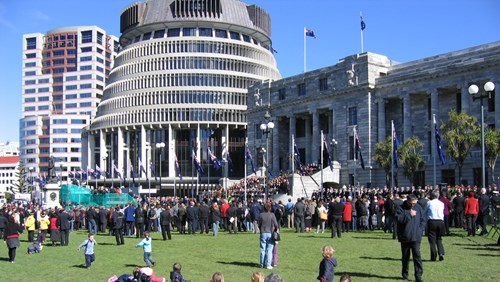
Campaign Housing Plans: Can They Solve Affordability Crisis?
Secure and affordable housing is a fundamental human right for all Australians.
Therefore, it is unsurprising the election campaign is being played out against a backdrop of heightened voter anxiety about rental stress and housing affordability. A growing number of people are unable to access housing that meets their needs.
And it’s not just low-income earners who are affected by housing pressures. It is also the millions of people who make up middle Australia; the very group that will help determine the election outcome.
The solution to Australia’s housing problem is complex. We need to start thinking differently about what reform might look like.
For most Australians, housing is their biggest and most unavoidable bill.
The average national weekly rent for a unit is A$566 a week. It is even higher in capital cities. To afford this comfortably, renters need an annual income of $130,000.
But for someone on the median income of $72,592 (or $58,575 after tax) half their pay packet is being swallowed by their weekly rent.
This significantly exceeds the 30% benchmark that is a useful measure of housing affordability stress.
The raw numbers are just as eye-watering for home ownership.
The mean price of a residential dwelling in Australia is around $977,000. For house hunters in New South Wales, the figure is even higher at $1.2 million.
Rapidly rising house prices over the past few years have contributed to larger home loans and more people with a mortgage.
Only 13% of homes sold in 2022-23 were affordable for a median income household, with housing prices increasing more rapidly than wages.
The cascading price pressures mean first home buyers are finding it harder to save for a deposit.
There is an urgent need for housing reform to overcome the affordability and accessibility challenges. There is no shortage of options available to policymakers.
For starters, planning rules and zoning regulations could be eased to facilitate more construction. Vacant commercial properties and office spaces could be repurposed as housing.
Another option includes removing barriers to constructing prefabricated homes, which are more efficient and affordable to build.
Housing reform often involves debate around negative gearing and capital gains tax concessions for property investors. There are mixed results regarding how they would impact housing affordability and accessibility. The unpopularity of such policies at the 2016 and 2019 elections have since hindered any changes.
But more radical reforms could be considered. They include applying negative gearing to first home buyers, who would benefit by claiming the mortgage interest on their property against their income. The United States allows home-owner couples to claim mortgage interest on the first US$750,000 (A$1.19 million) of their loan to help them secure a home.
The US policy highlights how high housing costs are not exclusive to Australia.
We could learn from other initiatives adopted overseas. For example, a bylaw passed in Montreal, Canada, requires new developments to include 20% social housing, 20% affordable housing and 20% family units.
Further, Vienna is known for its progressive social housing policies , which include rental caps and housing security. The housing is high quality and often includes access to communal pools, child care, libraries and other facilities.
Here in Australia, the major political parties are mindful that the high cost of housing is political kryptonite. They are fighting the May election armed with policies aimed at improving affordability and availability. But will these policies go far enough?
Labor plans to increase housing supply by 1.2 million homes over five years by changing zoning and planning rules. This includes 20,000 social housing homes and 10,000 affordable rentals for front-line workers such as police and nurses. It will also increase tax incentives for the build-to-rent program to increase rental supply.
These policies are likely to improve affordability and accessibility for lower income earners. However, there will be a wait while homes are constructed. It is also expensive at around $10 billion.
To increase supply, Labor will invest in prefabricated and modular homes, including a national certification system to streamline approvals.
Labor will also expand the Help-to-Buy scheme so more Australians can purchase their first home, although this may push-up prices through increased demand.
The Liberal Party’s policy centrepiece is $5 billion to fast track essential housing infrastructure such as water and sewage, to unlock up to 500,000 homes.
The Coalition is also vowing to free up more housing by reducing immigration by 25% and capping the number of international students.
For first home buyers, the Liberals want to allow early access to superannuation of up to $50,000, but studies suggest this could backfire by increasing house prices and hurting retirement savings.
Voters may find merit in one or more of the proposed policies, but bipartisanship will be essential if we are to solve the housing crisis, regardless of the election outcome.
And genuine reform involves more than sugar-hit policies that might find favour during election campaigns. It requires bold, decisive action with investment in areas that benefit those most in need.
Without genuine reform, even more Australians will struggle to put a roof over their heads. The ramifications will be devastating to Australia’s social and economic future.
The Australian dream of owning a home will be at risk of becoming an even bigger nightmare.
This is the third article in our special series, Australia’s Policy Challenges. You can read the other articles here and here
Michelle Cull is a member of CPA Australia, the Financial Advice Association Australia and President Elect of the Academy of Financial Services in the United States. Michelle is an academic member of UniSuper’s Consultative Committee. Michelle Cull co-founded the Western Sydney University Tax Clinic which has received funding from the Australian Taxation Office as part of the National Tax Clinic Program. Michelle has previously volunteered as Chair of the Macarthur Advisory Council for the Salvation Army Australia.


